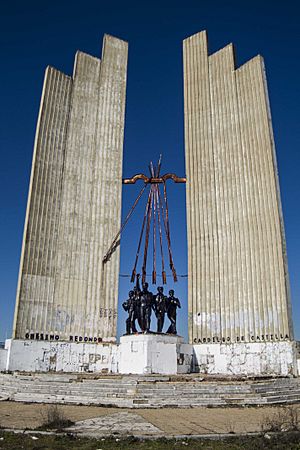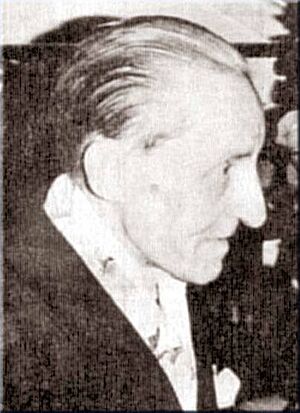Onésimo Redondo facts for kids
Quick facts for kids
Onésimo Redondo
|
|
|---|---|

Redondo (in the center, with arm raised) in a monument
|
|
| Born |
Onésimo Redondo Ortega
16 February 1905 |
| Died | 24 July 1936 (aged 31) |
| Cause of death | Killed in action |
| Monuments | Monument to Onésimo Redondo (now demolished) |
| Alma mater | University of Salamanca |
| Occupation | Lawyer, professor, writer, political activist |
| Years active | Mid-1920s–1936 |
| Known for | Francoist propaganda |
| Political party |
|
| Spouse(s) | Mercedes Sanz-Bachiller
(m. 1931–1936) |
Onésimo Redondo Ortega (born February 16, 1905 – died July 24, 1936) was a Spanish politician. He was a key figure in the early days of Falangism, a political movement in Spain. He helped create several political groups that later joined together to form the Falange Española.
Redondo, along with other leaders like Ramiro Ledesma and José Antonio Primo de Rivera, was important in spreading the ideas of the Francoist movement through what is called propaganda. This means he helped share messages to influence public opinion.
Contents
Early Life and Political Beginnings
Onésimo Redondo was born in a town called Quintanilla de Abajo (which was later renamed after him to Quintanilla de Onésimo) in Valladolid, Spain. His family owned land.
He studied law at the University of Salamanca. Later, he taught Spanish at the University of Mannheim in Germany from 1927 to 1928. During this time, he learned about Nazism, a political movement in Germany.
Redondo worked in Valladolid for a union of sugar beet farmers. He also joined a political group called Acción Nacional when he was young. He was influenced by Enrique Herrera Oria, who believed that communism, Freemasonry, and Judaism were trying to harm religion and Spain. This led Redondo to read books that spread ideas against Jewish people.
Founding New Political Groups
In 1931, the Second Spanish Republic was formed. After elections, a group of Republicans and gained power. Redondo did not like democracy and left Acción Nacional.
On June 13, 1931, he started an anti-Republican newspaper called Libertad in Valladolid. In this newspaper, he wrote strongly against Marxism, Jewish people, and bourgeois Capitalism. He also showed admiration for fascism in Europe.
In August 1931, Redondo started his own fascist party called Juntas Castellanas de Actuación Hispánica (Castilian Hispanic Action Groups). In November of the same year, his group joined with Ramiro Ledesma Ramos's group, La Conquista del Estado. Together, they formed the Juntas de Ofensiva Nacional Sindicalista (JONS).
These groups did not believe in participating in elections. Instead, they favored "direct action," which meant they wanted to achieve their goals through direct, sometimes forceful, means. They were against democracy and wanted to "exterminate" (get rid of) Marxist parties. Redondo's group sought out conflicts and armed themselves for street fights with working-class people in Valladolid.
Redondo often linked different groups he disliked, such as Moors, Jewish people, and the Left. He claimed that Marxism was a Jewish idea and that it would make Spain less European. He saw the fight against his political opponents as a new "Reconquista," like the historical battles to reclaim Spain from the Moors.
Role in the Spanish Civil War
In 1932, Redondo supported a failed attempt to overthrow the government led by General Sanjurjo. Because of this, he had to leave Spain and go to Portugal. He returned to Valladolid in April 1933.
On March 24, 1934, JONS and Falange Española merged to form a stronger political party.
Redondo was arrested on March 19, 1936, and moved to a prison in Ávila in June. He was set free by the Nationalists when the Spanish Civil War began.
He then helped organize the Falange's militias (groups of armed citizens) in Valladolid. He led groups that were involved in conflicts and violence against political opponents in the city. After this, he went to the Guadarrama mountains. He died in combat in Labajos, Segovia on July 24, 1936. The Francoist government later praised him as a war hero.
Legacy
Redondo's wife, Mercedes Sanz-Bachiller, started an organization called Auxilio de Invierno (Winter Aid). This group later became part of Auxilio Social (Social Aid), which was the welfare agency of the Falange and then part of the Francoist government.
In 1956, a university was established in Córdoba called Universidad Laboral "Onésimo Redondo" de Córdoba.

A monument honoring Redondo was built on top of Cerro San Cristóbal in Valladolid. This monument was opened in 1961. It was later taken down in February 2016, following a law about historical memory.
Writings
- Protocolos de los Sabios de Sión, Valladolid: Libertad, 1932 (translation and commentary).
- Onésimo Redondo, caudillo de Castilla, Valladolid: Libertad, 1937 (newspaper articles and political speeches)
- El Estado Nacional, Valladolid: Libertad, 1938
- Obras Completas: edición cronológica (2 vols.), Madrid: Publicaciones Españolas, 1954-1955
- Textos políticos. Madrid: Doncel, 1975.
See also
 In Spanish: Onésimo Redondo para niños
In Spanish: Onésimo Redondo para niños


